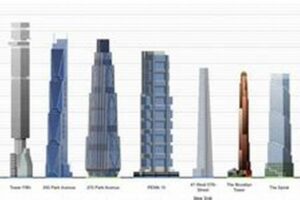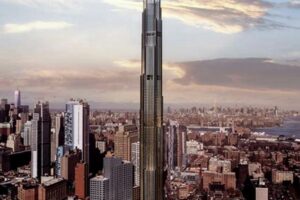New York City skyscrapers are among the tallest and most iconic buildings in the world. They are a symbol of the city’s power and ambition, and they have played a major role in shaping its skyline.
The first skyscraper in New York City was the Equitable Life Building, which was completed in 1873. It was only 10 stories tall, but it was the tallest building in the city at the time. Over the next few decades, a number of other skyscrapers were built in New York City, including the Woolworth Building, the Chrysler Building, and the Empire State Building.
Today, there are over 6,000 skyscrapers in New York City, making it the city with the most skyscrapers in the world. The tallest building in New York City is One World Trade Center, which was completed in 2014. It is 1,776 feet tall and is the tallest building in the Western Hemisphere.
1. Height
The height of NYC skyscrapers is a defining characteristic that sets them apart from buildings in other cities. The first skyscrapers were built in New York City in the late 19th century, and they quickly became a symbol of the city’s power and ambition. Today, there are over 6,000 skyscrapers in New York City, more than in any other city in the world.
- Engineering marvels: The construction of skyscrapers requires innovative engineering solutions to overcome challenges posed by height, wind, and seismic activity. Engineers have developed new materials and techniques to make skyscrapers taller and more resilient than ever before.
- Economic drivers: Skyscrapers house businesses of all sizes, from small startups to multinational corporations. They are a major source of jobs and economic activity for New York City.
- Cultural icons: NYC skyscrapers are instantly recognizable landmarks that have been featured in countless films, TV shows, and other works of art. They are a symbol of the city’s ambition and its role as a global center of commerce and culture.
- Tourism destinations: Many of NYC’s skyscrapers are open to the public, offering visitors breathtaking views of the city from observation decks and rooftop bars.
The height of NYC skyscrapers is a source of both pride and fascination. They are a testament to the city’s ingenuity, ambition, and economic power.
2. Architecture
The architecture of NYC skyscrapers is as diverse as the city itself. From the Art Deco skyscrapers of the 1920s and 1930s to the modern glass and steel skyscrapers of today, NYC’s skyscrapers reflect the city’s ever-changing skyline.
The early skyscrapers of New York City were designed in a variety of architectural styles, including Romanesque, Gothic, and Renaissance Revival. However, it was the Art Deco style that came to define the city’s skyscrapers in the 1920s and 1930s. Art Deco skyscrapers are characterized by their sleek lines, geometric shapes, and decorative details. Some of the most iconic Art Deco skyscrapers in New York City include the Chrysler Building, the Empire State Building, and the Rockefeller Center.
In the postwar era, the architecture of NYC skyscrapers began to change. Modernist architects rejected the ornamentation of Art Deco in favor of a more. Modernist skyscrapers are characterized by their simple lines, geometric shapes, and lack of ornamentation. Some of the most iconic modernist skyscrapers in New York City include the Seagram Building, the Lever House, and the United Nations Headquarters.
In recent years, the architecture of NYC skyscrapers has become even more diverse. Architects have experimented with new materials and technologies to create skyscrapers that are taller, lighter, and more sustainable than ever before. Some of the most innovative skyscrapers in New York City include the One World Trade Center, the Hudson Yards, and the High Line.
The diverse architecture of NYC skyscrapers is a reflection of the city’s ever-changing skyline. Skyscrapers have played a major role in shaping the city’s identity, and they continue to be a source of pride and fascination for New Yorkers and visitors alike.
3. Engineering
The engineering behind NYC skyscrapers is a marvel of human ingenuity and innovation. Skyscrapers are among the most complex and challenging structures to build, and they require a vast team of engineers, architects, and construction workers to bring them to life.
One of the most important challenges that engineers face when designing skyscrapers is the need to make them strong enough to withstand high winds and earthquakes. Skyscrapers are also incredibly tall, which means that they are subject to a lot of swaying and vibration. Engineers must carefully design the structure of the building to ensure that it can withstand these forces without collapsing.
Another challenge that engineers face is the need to make skyscrapers energy efficient. Skyscrapers consume a lot of energy, so it is important to design them in a way that minimizes their environmental impact. Engineers are constantly developing new ways to make skyscrapers more energy efficient, such as by using more efficient lighting systems and installing solar panels.
The engineering behind NYC skyscrapers is a testament to the human spirit of innovation and achievement. Skyscrapers are a symbol of human ingenuity and our ability to overcome challenges. They are a source of pride for New Yorkers and a reminder of the human capacity for greatness.
4. Business
Skyscrapers are not just symbols of architectural prowess but also play a pivotal role in the economic development of New York City. They house major corporations, financial institutions, and businesses of all sizes, contributing significantly to the city’s economic growth and prosperity.
The presence of corporate headquarters and financial institutions in skyscrapers creates a concentration of economic activity in the city. This attracts a skilled workforce, fosters innovation, and generates employment opportunities. Skyscrapers serve as hubs for business and finance, facilitating collaboration, networking, and the exchange of ideas.
For instance, the financial district in lower Manhattan is home to the New York Stock Exchange and numerous banks and investment firms. The presence of these institutions in skyscrapers has made New York City a global financial center, attracting businesses and investors from around the world.
Moreover, skyscrapers provide businesses with modern and efficient workspaces, equipped with state-of-the-art infrastructure and amenities. This enables businesses to operate seamlessly, meningkatkan produktivitas, and compete effectively in the global marketplace.
In conclusion, the connection between skyscrapers and business is integral to the economic landscape of New York City. Skyscrapers are not just architectural marvels but also engines of economic growth, providing a home for businesses, fostering innovation, and contributing to the city’s overall prosperity.
5. Tourism
The connection between tourism and NYC skyscrapers is undeniable. Iconic skyscrapers like the Empire State Building and One World Trade Center attract millions of tourists each year, contributing significantly to the city’s economy. These skyscrapers offer breathtaking views of the city, unique architectural experiences, and a glimpse into New York City’s rich history and culture.
For instance, the Empire State Building, standing at 1,454 feet, provides visitors with panoramic views of the city from its observation deck. Tourists can also learn about the building’s construction and history through interactive exhibits. Similarly, One World Trade Center, the tallest building in the Western Hemisphere, offers visitors an immersive experience through its multimedia exhibits and observation deck, providing a unique perspective of the city and its surroundings.
The popularity of these skyscrapers as tourist destinations has led to the development of, such as, , and tour operators. These businesses cater to the needs of tourists, enhancing their overall experience and contributing to the local economy. Moreover, the presence of iconic skyscrapers in New York City has helped to establish the city as a global tourist destination, attracting visitors from around the world.
In conclusion, the connection between tourism and NYC skyscrapers is mutually beneficial. Iconic skyscrapers attract tourists, boost the economy, and enhance the city’s global appeal. Understanding this connection is crucial for tourism policymakers and business owners to develop strategies that cater to the needs of tourists while preserving the architectural and cultural heritage of these iconic structures.
6. Sustainability
In the realm of NYC skyscrapers, sustainability has emerged as a driving force, shaping the design and construction of these architectural marvels. Recent skyscrapers in New York City have embraced sustainable practices, integrating innovative technologies and eco-friendly materials to minimize their environmental impact and promote energy efficiency.
- Energy Efficiency: Modern skyscrapers in NYC are designed to optimize energy consumption through the use of energy-efficient lighting systems, appliances, and HVAC systems. These measures significantly reduce the building’s energy footprint, contributing to a greener and more sustainable urban environment.
- Water Conservation: Sustainable skyscrapers employ rainwater harvesting systems, low-flow plumbing fixtures, and drought-tolerant landscaping to conserve water resources. These practices help reduce the strain on the city’s water supply and promote responsible water management.
- Material Selection: Architects and engineers are increasingly incorporating sustainable materials in skyscraper construction, such as recycled steel, low-VOC paints, and sustainably sourced wood. These choices minimize the environmental impact associated with material extraction and production.
- Green Roofs and Facades: Many new skyscrapers in NYC feature green roofs and facades, which provide insulation, reduce stormwater runoff, and improve air quality. These elements contribute to the overall sustainability of the building and enhance the urban ecosystem.
The incorporation of sustainable design elements in NYC skyscrapers represents a commitment to environmental stewardship and a recognition of the importance of preserving our planet’s resources. These skyscrapers serve as beacons of innovation, demonstrating that architectural excellence can coexist with sustainability.
As NYC continues to grow and evolve, the integration of sustainable practices in skyscraper design is expected to become even more prevalent. By embracing sustainability, NYC skyscrapers are not only shaping the city’s skyline but also contributing to a more sustainable and resilient future.
7. Cultural Impact
The connection between NYC skyscrapers and their cultural impact is undeniable. These architectural marvels have transcended their functional purpose, becoming iconic symbols of the city and American culture as a whole. Their distinctive silhouettes have graced countless films, TV shows, and literary works, shaping perceptions of New York City and contributing to its global allure.
As symbols of ambition, power, and innovation, NYC skyscrapers have played a prominent role in shaping the city’s cultural identity. Their presence in popular culture has helped to establish New York City as a global hub of commerce, finance, and entertainment. The Empire State Building, for instance, has featured in over 250 films, including iconic movies like “King Kong” and “Sleepless in Seattle.” Its observation deck has become a must-visit destination for tourists, offering breathtaking views of the city’s sprawling skyline.
Beyond their symbolic value, NYC skyscrapers have also served as settings for countless stories. Their unique architectural features and towering heights have provided filmmakers and writers with endless possibilities for creative expression. From the claustrophobic office spaces of “Mad Men” to the high-stakes corporate battles depicted in “Billions,” NYC skyscrapers have become characters in their own right, reflecting the city’s fast-paced and competitive environment.
Understanding the cultural impact of NYC skyscrapers is crucial for appreciating their significance beyond their architectural prowess. These buildings have become deeply ingrained in the city’s cultural fabric, serving as landmarks, symbols, and sources of inspiration. Their presence in popular culture has helped to shape perceptions of New York City around the world, contributing to its reputation as a vibrant and dynamic metropolis.
Frequently Asked Questions about NYC Skyscrapers
Welcome to our FAQ section, where we aim to provide clear and informative answers to common questions and misconceptions surrounding NYC skyscrapers. This section will delve into various aspects of these architectural marvels, offering insights into their history, design, and cultural significance.
Question 1: What is the tallest skyscraper in New York City?
Answer: The tallest skyscraper in New York City is One World Trade Center, standing at an impressive height of 1,776 feet.
Question 2: What was the first skyscraper built in New York City?
Answer: The Equitable Life Building, completed in 1873, holds the title of being the first skyscraper in New York City, reaching a height of 10 stories.
Question 3: How many skyscrapers are there in New York City?
Answer: As of 2023, New York City boasts over 6,000 skyscrapers, making it the city with the highest concentration of skyscrapers globally.
Question 4: What architectural styles are commonly found in NYC skyscrapers?
Answer: NYC skyscrapers showcase a diverse range of architectural styles, including Art Deco, Gothic Revival, Modernist, and contemporary designs.
Question 5: What are some of the most iconic skyscrapers in New York City?
Answer: The Empire State Building, Chrysler Building, and One World Trade Center are among the most iconic and recognizable skyscrapers in New York City.
Question 6: What is the cultural significance of NYC skyscrapers?
Answer: NYC skyscrapers have become cultural symbols, appearing in numerous films, TV shows, and literature, shaping perceptions of New York City.
We hope this FAQ section has provided valuable insights into NYC skyscrapers. For further exploration, we encourage you to delve into the other sections of our article, where we delve deeper into the history, design, and impact of these architectural wonders.
Stay tuned for more informative content on NYC skyscrapers and other fascinating topics.
Tips on Appreciating NYC Skyscrapers
To fully appreciate the grandeur and significance of NYC skyscrapers, consider these insightful tips:
Tip 1: Explore from Different Perspectives
Experience NYC skyscrapers from various vantage points. Admire their towering heights from street level, marvel at their intricate details during a guided tour, and ascend to observation decks for breathtaking panoramic views.
Tip 2: Learn About Their History and Architecture
Delve into the rich history and architectural styles of NYC skyscrapers. Discover the stories behind their construction, the innovative engineering techniques employed, and the renowned architects who designed them.
Tip 3: Visit Iconic Skyscrapers
Make sure to visit iconic skyscrapers such as the Empire State Building, Chrysler Building, and One World Trade Center. These landmarks offer unique architectural experiences and provide a glimpse into the evolution of skyscraper design.
Tip 4: Take Advantage of Observation Decks
Ascend to the observation decks of NYC skyscrapers to witness unparalleled city views. Capture breathtaking photos, enjoy dining experiences with panoramic vistas, and gain a new perspective on the city’s vastness.
Tip 5: Appreciate the Cultural Significance
Recognize the cultural significance of NYC skyscrapers. They have served as backdrops for countless films and television shows, inspiring awe and wonder. Explore the cultural impact of these architectural marvels.
Tip 6: Attend Events and Exhibitions
Participate in events and exhibitions held in or around NYC skyscrapers. These events often provide exclusive access, behind-the-scenes tours, and educational programs that enhance your understanding and appreciation.
By following these tips, you will gain a deeper appreciation for the architectural wonders that define the New York City skyline.
In conclusion, NYC skyscrapers are not just towering structures but symbols of innovation, ambition, and cultural heritage. By embracing these tips, you can fully immerse yourself in the grandeur and significance of these architectural marvels.
Conclusion
New York City skyscrapers stand as testaments to human ingenuity, architectural prowess, and economic might. They have shaped the city’s skyline and played a pivotal role in its history and development. From the early skyscrapers of the late 19th century to the modern marvels of today, these towering structures have pushed the boundaries of engineering and design.
The diverse architectural styles, innovative engineering solutions, and sustainable practices employed in NYC skyscrapers showcase the city’s commitment to innovation and environmental consciousness. These buildings house major corporations, financial institutions, and businesses of all sizes, contributing significantly to the city’s economic prosperity and global influence. As iconic cultural symbols, NYC skyscrapers have featured prominently in countless works of art, literature, and popular culture, shaping perceptions of New York City around the world.
As we look to the future, NYC skyscrapers will undoubtedly continue to evolve, incorporating cutting-edge technologies and sustainable practices to meet the challenges and opportunities of the 21st century. These architectural wonders will remain symbols of human ambition and achievement, inspiring awe and wonder in generations to come.







